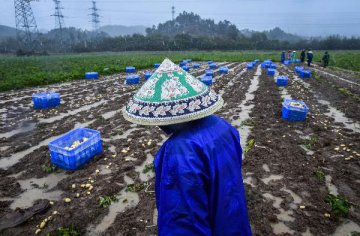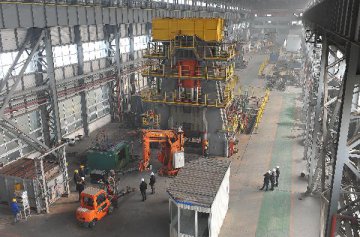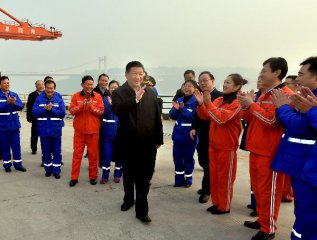
The supply-side structural reform was determined as the focus of work in the year, the Communist Party of China's (CPC) Central Committee made the decision at a meeting convened on Feb. 22 when discussing the draft of the government work report for this year, However, before the report is delivered at the National People's Congress (NPC) for deliberation, various central ministries and commissions have already actively issued policies.
The reporter summarized the policies and noted that such policies mainly focus on cutting excessive production capacity in iron & steel and coal industries, destocking housing inventory, continuously alleviating burdens of enterprises through streamlining administration and delegating power to the lower levels, implementing a new round of rural electric network modification to improve the weakness and so forth. Particularly, destocking housing inventory has seen the most intensive policies. Over ten ministries and commissions have consecutively launched five major policies since the beginning of February, which involve lowering down payment, rising the deposit interest rate of housing provident fund, reducing relevant expenses and taxation in real estate transactions, standardizing land reserve and fund management. Besides, more specific policies on supply-side reform are likely to be introduced in the first half of the year.
Intensive policies launched on reducing excessive housing stocks
In this year’s supply-side reform, cutting excessive production capacity is the most noticeable, and the target is very clear.
On Feb.4 and 5, the State Council issued the Opinions on Absorbing Excessive Production Capacity and Realizing Profits and Development in Coal Industry and the Opinions on Absorbing Excessive Production Capacity and Realizing Profits and Development in Steel Industry. The State Council has set a quantitative goal of capacity reduction of coal: close down about 500 million tons of production capacity and reduce and restructure about 500 million tons in three to five years from 2016.
In order to achieve the goals of the Opinions, the National Energy Administration (NEA) on Feb. 18 convened a meeting and detailed the tasks of cutting excessive production capacity. It proposes to close down more than 1,000 outdated coal mines in 2016 with total capacity of 60 million tons.
On Feb. 19, the National Development and Reform Commission (NDRC), the Ministry of Industry and Information Technology (MIIT) and the State-owned Assets Supervision and Administration Commission (SASAC) jointly convened a video and telephone conference related to work arrangement of the absorption of excessive production capacity of steel. The conference put forward to comprehensively prohibit new steel capacity, and close down excessive production capacity according to laws and regulations and guide enterprises to voluntarily obliterate overcapacity.
Significantly, reducing housing stocks has witnessed the most intensive policies among all the tasks. According to incomplete statistics from the Shanghai Securities News (SSN), in just about 20 days in February, ten ministries and commissions, among others, the central bank and the NDRC, have issued five key policies in succession. That is to say, new policies about housing market are introduced almost every week.
On Feb. 2, the central bank and the China Banking Regulatory Commission (CBRC) announced to cut mortgage down payment of first homes to 25 percent in cities without purchase restrictions. The minimum mortgage down payment could be reduced to as low as 20 percent.
On Feb. 14, eight ministries including the central bank, the NDRC and the MIIT, jointly issued the Certain Opinions of Stabilizing Growth, Adjusting Structure and Improving Efficiency for Industry by Finance, and the Article 7 of which proposes to “accelerate securitization of hosing loan assets”.
On Feb. 17, the central bank, the Ministry of Housing and Urban-Rural Development (MOHURD) and the Ministry of Finance published a notice to raise the deposit interest rate for housing provident fund from the current due on demand and three-month benchmark deposit rates depending on when the deposits were placed, to the one-year benchmark deposit rate.
On the same day, the Ministry of Finance, the State Administration of Taxation and the MOHURD issued another notice to lower relevant expenses and taxation in real estate transactions. For households buying the first home or a second home to improve living standard with an area of less than 90 square meters, the deed tax will be reduced to 1 percent.
On Feb. 23, the Ministry of Finance, the Ministry of Land and Resources, the central bank and the CBRC jointly issued the Notice on Standardizing Land Reserve and Capital Management Related Issues, which requires that local governments shall not borrow land reserve loans from banking financial institutions since Jan.1, 2016.
“In all the policies, the most effective one is to lower down payment of commercial loans to 20 percent. It is even more efficient than interest rates cut,” Yan Yuejin, chief researcher at E-house China R&D Institute, told the reporter from SSN in an interview.
Yan said that in the current situation, except the first-tier cities and provincial capitals, all third and fourth-tier cities are able to implement this policy. In the future, home purchases in such cities are likely to be more active, and which in turn will further speed up destocking in the real estate market across the country.
Supportive reform documents to release in first half year
A meeting of the Political Bureau of the CPC Central Committee convened on Monday made it explicit again that the supply-side structural reform will be reinforced. The meeting proposed that it will work hard on cutting excessive production capacity, de-stocking, deleverage, cost reduction and the improvement of weakness, enhance people’s livelihood and guard against risks in in key areas.
It is foreseeable that the supply-side reform will be highlighted in the government work report this year. The central government is now mulling on schemes for the supply-side reform. The missions of the supply-side reform will be further decomposed in the future and the State Council will launch documents for implementation, as estimated by analysts.
China International Capital Corporation Limited (CICC) points out in its latest research report that “cutting excessive production capacity, de-stocking, deleverage, cost reduction and improvement of weakness” will be further decomposed and defined, and relevant documents will be gradually unveiled in the first half year.
In fact, besides policies launched by the central government, ministries and commissions as well as local governments will also take multiple measures for the supply-side reform.
As to capacity reduction, SSN reporter learnt that the State-owned Assets Supervision and Administration Commission (SASAC) will propose the total size of the capacity to be withdrawn as well as the detailed size and timetable for enterprises after the State Council releases its opinions on the capacity reduction in coal and iron & steel industries. Implementation schemes and supporting policies will be worked out accordingly later.
As to cost reduction, the State Council has required clearing and standardizing a batch of governmental fund charging items at the beginning of the year, a move trying to alleviate the burdens on enterprises. Zhang Mao, head of the State Administration for Industry and Commerce, disclosed at a State Council Information Office news conference held on Feb. 22 that “the State Administration for Industry and Commerce proposes to work together with the tax department this year to cut the registration time and cost for individual business.”
Commerce Minister Gao Hucheng indicated on a State Council Information Office news conference held on Feb. 23 that the supply-side reform will mainly focus on issues related to the varieties, price and quality of commodities, safety, shopping environment and etc. in 2016. He also mentioned that taxes and dues will be adjusted and the high cost of logistics in particular will be reduced.
While the destocking policies for the real estate market remains to be the most widely concerned area. Analysts interviewed by SSN reporter all believe that more supporting policies will be launched later.
Yan Yuejin holds that new policies might be introduced nationwide for the establishment of a market promoting both house purchasing and renting and the implementation of deducting individual income tax from the interest rate of house loans.
Xia Dan, a researcher with the Bank of Communications’ Financial Research Center, also believes that though the home transactions taxes has been lowered, further adjustment is expected. In addition, the interest rate for purchasing second home still has room to be further reduced and the loans people get from housing provident fund can be further increased.
Translated by Adam Zhang and Jennifer Lu
























Latest comments